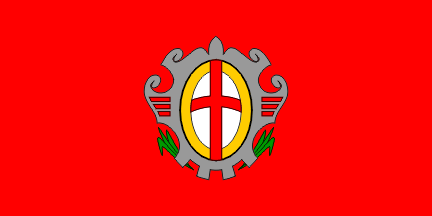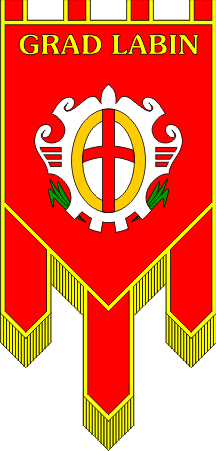
image by Željko Heimer, 20 Febuary 2004

Last modified: 2010-01-22 by dov gutterman
Keywords: istria | labin | republic of labin | albona |
Links: FOTW homepage |
search |
disclaimer and copyright |
write us |
mirrors

image by Željko Heimer, 20 Febuary 2004
See also:
Other Sites:
The coat of arms of Labin is Argent a Cross Gules like that of
several other Istrian cities. The representation within oval
golden bordered shield and in silver cartouche makes it unique.
The loewer end of the cratouche is reminding on the cog wheel as
Labin are is the most industriall developed part of Istria.
Željko Heimer
The town of Albona (Labin in Croatian language) was occupied
by Italian forces at the end of WWI. It was then annexed by Italy
after the Treaty of Rapallo (12 November 1920). On 2 March 1921
the miners of Albona made a strike and they proclaimed the
"Republic of Albona" with a clearly socialist
organization. The town was soon encircled by the Army and
surrendered without fightings on 8 April 1921. The leaders of the
strikers were put on trial and acquitted by the tribunal of Pola
(now called Pula). Of course this rebellion has nothing to do
with anti-Fascism: Italy was still a democratic country and
Mussolini became Prime Minister only on 30 October 1922 (one year
and a half after the end of the Republic of Albona).
Guido Abate, 31 December 2002
Labin is some 30 km north east of Pula, the city area counts
some 13,000 inhabitants, about 9,000 of them living in the city
itself. The white flag with the coat of arms that was reported in
late 1990's (see: Previous Flags) is not used
any more, since the 2001 Statutes available on line at <www.labin.hr>: Statut Grada
Labina, 09.10.2001, Službene novine Grada Labina, clearly
states in the article 5 that the flag is red with the coat of
arms in the middle (in full colours). The coat of arms is
blazoned there so: " The coat of arms of Labin is the
historical coat of arms, in an oval (egglike) shield argent a red
convex cross bordered with a golden hatched ring, all on a silver
cartuche flanked on both sides with three horizontal red lines
and with green lilly branches in the base.
Željko Heimer, 20 Febuary 2004
I have spoted it today on a Croatian TV report from Labin (HRT
1, 22 March 2009). The ceremonial flag is apparently kept in the
city assembly hall.
The ceremonial flag is a red gonfalon wending
triangularly and with three tails, edged yellow and with yellow
fringe along the bottom. In the middle of it is the coat of arms
in full colours and above it the name of the city.
Željko Heimer, 22 March 2009
The city web site includes
the latter years of the official gazette. The new city Statutes
of 2006 replace the 2001 Statutes we quote above, but the wording
on the coat of arms and the flag remains word for word the same:
Statut Grada Labina, 14.03.2006, Službene novine Grada
Labina, br. 3/2006.
The subsequent issue of the gazette includes a decesion on grant
of use of arms to a local cycling club "Istra Bike",
where we learn on the decision adopting the arms and flag from
1993 (so old issues of the gazette are not on line): Odluka o
grbu i zastavi Grada Labina. Službene novine Grada Labina,
br. 3/93. quoted in Odluka o dozvoli uporabe grba Grada Labina,
06.04.2006, Službene novine Grada Labina, br. 4/2006.
Therefore the current coat of arms and flag were adopted in 1993.
(Although, variations of the flag were still used in 1997, as I
reported from my visit to Labin then).
Željko Heimer, 5 September 2009

image by Željko Heimer, 22 March 2009
First Flag
![[Flag of Labin]](../images/h/hr-labin.gif)
image by Željko Heimer, 20 Febuary 2004
Red flag with (white) monochrome representation of city arms.
In fact, I have seem the same flag in yellow or blue insted of
red on several places in the town. They all might be unofficial.
Labin is city in eastern part of Istria, once important for its
coal mines and industry, today turistical center. Major uprising
was made in Labin when Istria was anexed by Italy (in 1924?)
called "Republic of Labin" that lasted for a week or
so, based on socialist principles. It's flag was, of course, red.
The uprising is counted by some as the first anti-fascist
movement in Europe.
Željko Heimer, 2 August 1997
Intermediate Flag